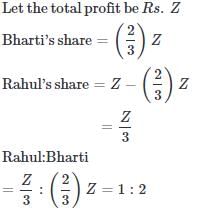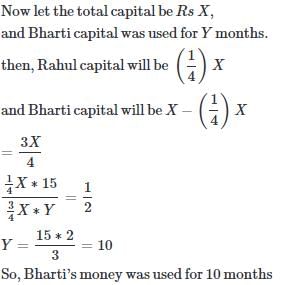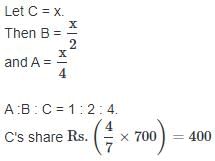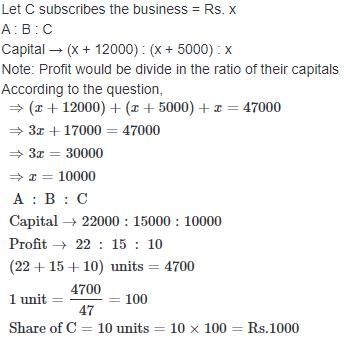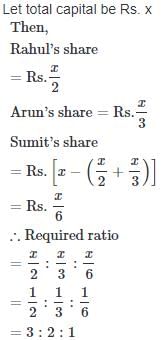All Exams >
CLAT >
4 Months Preparation Course for CLAT UG >
All Questions
All questions of Partnership for CLAT Exam
P, Q, R enter into a partnership. P initially invests 25 lakh & adds another 10 lakhs after one year. Q initially invests 35 lakh & withdrawal 10 lakh after 2 years and R invests Rs 30 Lakhs . In what ratio should the profit be divided at the end of 3 years?- a)18 : 19 : 19
- b)18 : 18 : 19
- c)19 : 19 : 18
- d)None of these
Correct answer is option 'C'. Can you explain this answer?
P, Q, R enter into a partnership. P initially invests 25 lakh & adds another 10 lakhs after one year. Q initially invests 35 lakh & withdrawal 10 lakh after 2 years and R invests Rs 30 Lakhs . In what ratio should the profit be divided at the end of 3 years?
a)
18 : 19 : 19
b)
18 : 18 : 19
c)
19 : 19 : 18
d)
None of these

|
Om Banerjee answered |
P : Q : R
= (25 × 1 + 35 × 2) : (35 × 2 : 25 × 1) : (30 × 3)
= 95 : 95 : 90
= 19 : 19: 18
= (25 × 1 + 35 × 2) : (35 × 2 : 25 × 1) : (30 × 3)
= 95 : 95 : 90
= 19 : 19: 18
Two brother invested Rs. 50000 and Rs. 70000 respectively in a business and agreed that 70% of the profits should be divided equally between them and the remaining profit in the ratio of investment. If one brothers gets Rs. 90 more than the other. Find the total profit made in the business ?- a)Rs. 1200
- b)Rs. 1400
- c)Rs. 1600
- d)Rs. 1800
Correct answer is option 'D'. Can you explain this answer?
Two brother invested Rs. 50000 and Rs. 70000 respectively in a business and agreed that 70% of the profits should be divided equally between them and the remaining profit in the ratio of investment. If one brothers gets Rs. 90 more than the other. Find the total profit made in the business ?
a)
Rs. 1200
b)
Rs. 1400
c)
Rs. 1600
d)
Rs. 1800

|
Aashna Roy answered |
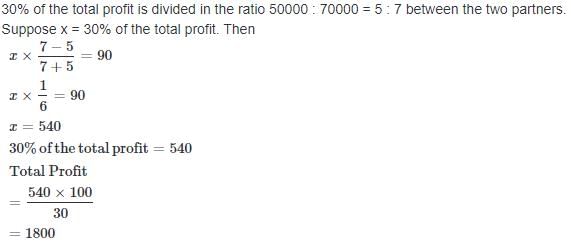
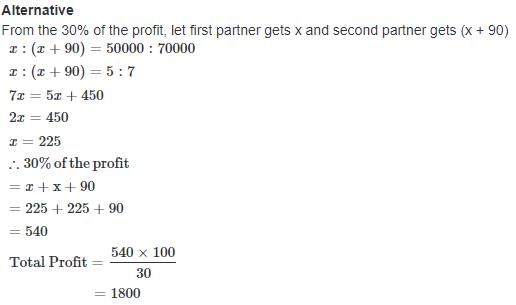
Two partners invest Rs. 125000 and Rs. 85000 respectively in a business and agree that 60% of the profit should be divided equally between them and the remaining profit is to be divided into ratio of their capitals. If one partner gets Rs. 300 more than the other. Find the total profit made in the business ?- a)Rs. 3739.50
- b)Rs. 3937.50
- c)Rs. 3749.50
- d)Rs. 3947.50
Correct answer is option 'B'. Can you explain this answer?
Two partners invest Rs. 125000 and Rs. 85000 respectively in a business and agree that 60% of the profit should be divided equally between them and the remaining profit is to be divided into ratio of their capitals. If one partner gets Rs. 300 more than the other. Find the total profit made in the business ?
a)
Rs. 3739.50
b)
Rs. 3937.50
c)
Rs. 3749.50
d)
Rs. 3947.50

|
Juhi Yadav answered |
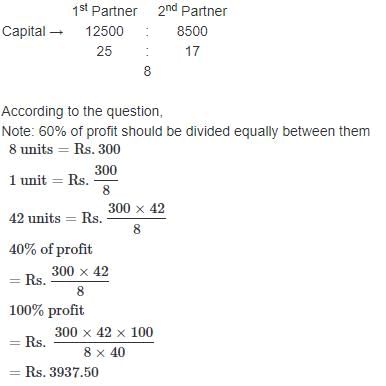
Aman started a business investing Rs. 70000. Rakhi joined him after six months with an amount of Rs. 105000 and Sagar joined them with Rs. 1.4 lakhs after another six months. The amount of profit earned should be distributed in what ratio among Aman, Rakhi and Sagar respectively, 3 years after Aman started the business ?- a)7 : 6 : 10
- b)12 : 15 : 16
- c)42 : 45 56
- d)Cannot be determined
- e)None of these
Correct answer is option 'B'. Can you explain this answer?
Aman started a business investing Rs. 70000. Rakhi joined him after six months with an amount of Rs. 105000 and Sagar joined them with Rs. 1.4 lakhs after another six months. The amount of profit earned should be distributed in what ratio among Aman, Rakhi and Sagar respectively, 3 years after Aman started the business ?
a)
7 : 6 : 10
b)
12 : 15 : 16
c)
42 : 45 56
d)
Cannot be determined
e)
None of these
|
|
Aarav Sharma answered |
Let's calculate the profit distribution step by step:
Step 1: Calculate the total investment
- Aman invested Rs. 70,000 for the entire 3-year period.
- Rakhi invested Rs. 1,05,000 for the last 2.5 years.
- Sagar invested Rs. 1,40,000 for the last 1.5 years.
To calculate the total investment, we need to consider the time period for each investment.
- Aman's investment is for the entire 3 years.
- Rakhi's investment is for the last 2.5 years.
- Sagar's investment is for the last 1.5 years.
So, the total investment will be:
Aman's investment = Rs. 70,000 × 3 = Rs. 210,000
Rakhi's investment = Rs. 1,05,000 × 2.5 = Rs. 262,500
Sagar's investment = Rs. 1,40,000 × 1.5 = Rs. 210,000
Total investment = Aman's investment + Rakhi's investment + Sagar's investment
= Rs. 210,000 + Rs. 262,500 + Rs. 210,000
= Rs. 682,500
Step 2: Calculate the profit distribution ratio
The profit distribution ratio is based on the ratio of investments made by Aman, Rakhi, and Sagar.
Aman's share = Aman's investment / Total investment
= Rs. 210,000 / Rs. 682,500
= 7/ 22
Rakhi's share = Rakhi's investment / Total investment
= Rs. 262,500 / Rs. 682,500
= 15 / 44
Sagar's share = Sagar's investment / Total investment
= Rs. 210,000 / Rs. 682,500
= 16 / 45
Therefore, the profit distribution ratio among Aman, Rakhi, and Sagar is 7:15:16.
So, the correct answer is option B) 12:15:16.
Step 1: Calculate the total investment
- Aman invested Rs. 70,000 for the entire 3-year period.
- Rakhi invested Rs. 1,05,000 for the last 2.5 years.
- Sagar invested Rs. 1,40,000 for the last 1.5 years.
To calculate the total investment, we need to consider the time period for each investment.
- Aman's investment is for the entire 3 years.
- Rakhi's investment is for the last 2.5 years.
- Sagar's investment is for the last 1.5 years.
So, the total investment will be:
Aman's investment = Rs. 70,000 × 3 = Rs. 210,000
Rakhi's investment = Rs. 1,05,000 × 2.5 = Rs. 262,500
Sagar's investment = Rs. 1,40,000 × 1.5 = Rs. 210,000
Total investment = Aman's investment + Rakhi's investment + Sagar's investment
= Rs. 210,000 + Rs. 262,500 + Rs. 210,000
= Rs. 682,500
Step 2: Calculate the profit distribution ratio
The profit distribution ratio is based on the ratio of investments made by Aman, Rakhi, and Sagar.
Aman's share = Aman's investment / Total investment
= Rs. 210,000 / Rs. 682,500
= 7/ 22
Rakhi's share = Rakhi's investment / Total investment
= Rs. 262,500 / Rs. 682,500
= 15 / 44
Sagar's share = Sagar's investment / Total investment
= Rs. 210,000 / Rs. 682,500
= 16 / 45
Therefore, the profit distribution ratio among Aman, Rakhi, and Sagar is 7:15:16.
So, the correct answer is option B) 12:15:16.
A and B started a partnership business investing some amount in the ratio of 3 : 5. C joined then after six months with an amount equal to that of B. In what proportion should the profit at the end of one year be distributed among A, B and C?- a)3 : 5 : 2
- b)3 : 5 : 5
- c)6 : 10 : 5
- d)Data inadequate
Correct answer is option 'C'. Can you explain this answer?
A and B started a partnership business investing some amount in the ratio of 3 : 5. C joined then after six months with an amount equal to that of B. In what proportion should the profit at the end of one year be distributed among A, B and C?
a)
3 : 5 : 2
b)
3 : 5 : 5
c)
6 : 10 : 5
d)
Data inadequate

|
Gayatri Ahuja answered |
Let initial investment of A is 3x and B is 5x, then C investment is also 5x, but most important to note in this question is the time duration of investment
Like, A invested for 12 months, B invested for 12 months and C invested for 6 months.
A : B : C = (3x x 12) : (5x x 12) : (5x x 6)
= 36 : 60 : 30
= 6 : 10 : 5.
Like, A invested for 12 months, B invested for 12 months and C invested for 6 months.
A : B : C = (3x x 12) : (5x x 12) : (5x x 6)
= 36 : 60 : 30
= 6 : 10 : 5.
Aman started a business investing Rs. 70,000. Rakhi joined him after six months with an amount of Rs. 1,05,000 and Sagar joined them with Rs. 1.4 lakhs after another six months. The amount of profit earned should be distributed in what ratio among Aman, Rakhi and Sagar respectively, 3 years after Aman started the business?- a)7 : 6 : 10
- b)12 : 15 : 16
- c)42 : 45 : 56
- d)Cannot be determined
Correct answer is option 'B'. Can you explain this answer?
Aman started a business investing Rs. 70,000. Rakhi joined him after six months with an amount of Rs. 1,05,000 and Sagar joined them with Rs. 1.4 lakhs after another six months. The amount of profit earned should be distributed in what ratio among Aman, Rakhi and Sagar respectively, 3 years after Aman started the business?
a)
7 : 6 : 10
b)
12 : 15 : 16
c)
42 : 45 : 56
d)
Cannot be determined

|
Partho Das answered |
Aman : Rakhi : Sagar
= (70,000 x 36) : (1,05,000 x 30) : (1,40,000 x 24)
= 12 : 15 : 16.
= (70,000 x 36) : (1,05,000 x 30) : (1,40,000 x 24)
= 12 : 15 : 16.
Simran started a software business by investing Rs. 50000. After six months, Nanda joined her with a capital of Rs. 80000.After 3 year they earned a profit of Rs 24500 What was Simran's share in the profit?
- a)Rs. 9423
- b)Rs. 10250
- c)Rs. 12500
- d)Rs. 14000
- e)Rs. 10500
Correct answer is option 'E'. Can you explain this answer?
Simran started a software business by investing Rs. 50000. After six months, Nanda joined her with a capital of Rs. 80000.After 3 year they earned a profit of Rs 24500 What was Simran's share in the profit?
a)
Rs. 9423
b)
Rs. 10250
c)
Rs. 12500
d)
Rs. 14000
e)
Rs. 10500
|
|
Aarav Sharma answered |
Given:
Simran invested Rs. 50000
Nanda invested Rs. 80000 after 6 months
To calculate:
Simran's share in the profit
Solution:
Let's calculate the ratio of their profits.
Simran invested for 12 months, whereas Nanda invested for 6 months only.
Simran's investment = Rs. 50000 x 12 = Rs. 600000
Nanda's investment = Rs. 80000 x 6 = Rs. 480000
Ratio of their investments = 600000:480000 = 5:4
Let the total profit be x
Simran's share in the profit = (5/9) x
Now, let's substitute the value of x
Total profit = profit of Simran + profit of Nanda
x = (5/9) x + (4/9) x
Simplifying this equation, we get
(4/9) x = Rs. 10500
Therefore, Simran's share in the profit = (5/9) x (Total profit) = (5/9) x Rs. 10500 = Rs. 5833.33
Hence, the closest option to the calculated answer is option E, Rs. 10500.
Simran invested Rs. 50000
Nanda invested Rs. 80000 after 6 months
To calculate:
Simran's share in the profit
Solution:
Let's calculate the ratio of their profits.
Simran invested for 12 months, whereas Nanda invested for 6 months only.
Simran's investment = Rs. 50000 x 12 = Rs. 600000
Nanda's investment = Rs. 80000 x 6 = Rs. 480000
Ratio of their investments = 600000:480000 = 5:4
Let the total profit be x
Simran's share in the profit = (5/9) x
Now, let's substitute the value of x
Total profit = profit of Simran + profit of Nanda
x = (5/9) x + (4/9) x
Simplifying this equation, we get
(4/9) x = Rs. 10500
Therefore, Simran's share in the profit = (5/9) x (Total profit) = (5/9) x Rs. 10500 = Rs. 5833.33
Hence, the closest option to the calculated answer is option E, Rs. 10500.
Two friends invested Rs.1500 and Rs. 2500 in a business. They earned a profit of Rs. 800. One-half of the profit was divided equally between them and the other half was divided in proportion to their capitals. How much did each of them receive ?- a)Rs. 350 and Rs. 450
- b)Rs. 360 and Rs. 440
- c)Rs. 370 and Rs. 430
- d)Rs. 375 and Rs. 425
Correct answer is option 'A'. Can you explain this answer?
Two friends invested Rs.1500 and Rs. 2500 in a business. They earned a profit of Rs. 800. One-half of the profit was divided equally between them and the other half was divided in proportion to their capitals. How much did each of them receive ?
a)
Rs. 350 and Rs. 450
b)
Rs. 360 and Rs. 440
c)
Rs. 370 and Rs. 430
d)
Rs. 375 and Rs. 425

|
Prashanth Ghoshal answered |
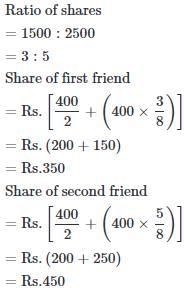
A, B and C jointly thought of engaging themselves in a business venture. It was agreed that A would invest Rs. 6500 for 6 months, B, Rs. 8400 for 5 months and C, Rs. 10,000 for 3 months. A wants to be the working member for which, he was to receive 5% of the profits. The profit earned was Rs. 7400. Calculate the share of B in the profit.- a)Rs. 1900
- b)Rs. 2660
- c)Rs. 2800
- d)Rs. 2840
Correct answer is option 'B'. Can you explain this answer?
A, B and C jointly thought of engaging themselves in a business venture. It was agreed that A would invest Rs. 6500 for 6 months, B, Rs. 8400 for 5 months and C, Rs. 10,000 for 3 months. A wants to be the working member for which, he was to receive 5% of the profits. The profit earned was Rs. 7400. Calculate the share of B in the profit.
a)
Rs. 1900
b)
Rs. 2660
c)
Rs. 2800
d)
Rs. 2840

|
Vandana Sarkar answered |
For managing, A received = 5% of Rs. 7400 = Rs. 370.
Balance = Rs. (7400 - 370) = Rs. 7030.
Ratio of their investments = (6500 x 6) : (8400 x 5) : (10000 x 3)
= 39000 : 42000 : 30000
= 13 : 14 : 10
∴ B's Share

Balance = Rs. (7400 - 370) = Rs. 7030.
Ratio of their investments = (6500 x 6) : (8400 x 5) : (10000 x 3)
= 39000 : 42000 : 30000
= 13 : 14 : 10
∴ B's Share

Anand and Deepak started a business investing Rs.22,500 and Rs.35,000 respectively. Out of a total profit of Rs. 13,800. Deepak's share is- a)Rs 9600
- b)Rs 8500
- c)Rs 8450
- d)Rs 8400
Correct answer is option 'D'. Can you explain this answer?
Anand and Deepak started a business investing Rs.22,500 and Rs.35,000 respectively. Out of a total profit of Rs. 13,800. Deepak's share is
a)
Rs 9600
b)
Rs 8500
c)
Rs 8450
d)
Rs 8400

|
Varun Nambiar answered |
Ratio of their shares = 22500 : 35000
=9 : 14
Deepak's share

=9 : 14
Deepak's share

P, Q and R invested Rs. 45000, Rs. 70000 and Rs. 90000 respectively to start a business. At the end of 2 years, they earned a profit of Rs.164000. What will be Q's share in the profit ?- a)Rs. 36000
- b)Rs. 56000
- c)Rs. 64000
- d)Rs. 72000
- e)None of these
Correct answer is option 'B'. Can you explain this answer?
P, Q and R invested Rs. 45000, Rs. 70000 and Rs. 90000 respectively to start a business. At the end of 2 years, they earned a profit of Rs.164000. What will be Q's share in the profit ?
a)
Rs. 36000
b)
Rs. 56000
c)
Rs. 64000
d)
Rs. 72000
e)
None of these

|
Sarthak Chatterjee answered |
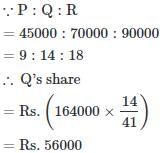
A starts business with Rs. 3500 and after 5 months, B joins with A as his partner. After a year, the profit is divided in the ratio 2 : 3. What is B's contribution in the capital?- a)Rs. 7500
- b)Rs. 8000
- c)Rs. 8500
- d)Rs. 9000
Correct answer is option 'D'. Can you explain this answer?
A starts business with Rs. 3500 and after 5 months, B joins with A as his partner. After a year, the profit is divided in the ratio 2 : 3. What is B's contribution in the capital?
a)
Rs. 7500
b)
Rs. 8000
c)
Rs. 8500
d)
Rs. 9000

|
Om Banerjee answered |
Let B's capital be Rs. x
∴ A's share in 12 months=3500 × 12
And, B's share in 7 months=7x
Let B's capitalbe Rs.x

⇒14x=126000
⇒x=9000
∴ A's share in 12 months=3500 × 12
And, B's share in 7 months=7x
Let B's capitalbe Rs.x

⇒14x=126000
⇒x=9000
Dilip, Ram and Avtar started a shop by investing Rs. 2700, Rs. 8100 and Rs. 7200 respectively. At the end of one year, the profit earned was distributed. If Ram's share was Rs. 3600, what was their total profit ?- a)Rs. 8000
- b)Rs. 10800
- c)Rs. 11600
- d)Data inadequate
Correct answer is option 'A'. Can you explain this answer?
Dilip, Ram and Avtar started a shop by investing Rs. 2700, Rs. 8100 and Rs. 7200 respectively. At the end of one year, the profit earned was distributed. If Ram's share was Rs. 3600, what was their total profit ?
a)
Rs. 8000
b)
Rs. 10800
c)
Rs. 11600
d)
Data inadequate

|
Aashna Roy answered |
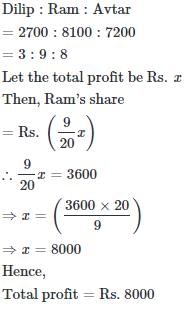
We have to divided a sum of Rs. 13950 among three persons A, B and C. B must get the double of A's share and C must get 50 less than the double of B's share. The share of A will be ?- a)Rs. 1950
- b)Rs. 1981.25
- c)Rs. 2000
- d)Rs. 2007.75
Correct answer is option 'C'. Can you explain this answer?
We have to divided a sum of Rs. 13950 among three persons A, B and C. B must get the double of A's share and C must get 50 less than the double of B's share. The share of A will be ?
a)
Rs. 1950
b)
Rs. 1981.25
c)
Rs. 2000
d)
Rs. 2007.75

|
Swati Yadav answered |
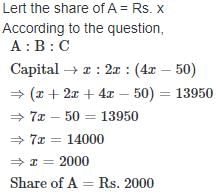
A, B and C enter into a partnership. A invests some money at the beginning, B invests double the amount after six months and C invest thrice the amount after eight months. If the annual profit be Rs. 27000; C's share (in Rs.) is ?- a)Rs. 8625
- b)Rs. 9000
- c)Rs. 10800
- d)Rs. 11250
Correct answer is option 'B'. Can you explain this answer?
A, B and C enter into a partnership. A invests some money at the beginning, B invests double the amount after six months and C invest thrice the amount after eight months. If the annual profit be Rs. 27000; C's share (in Rs.) is ?
a)
Rs. 8625
b)
Rs. 9000
c)
Rs. 10800
d)
Rs. 11250

|
Sanjana Patel answered |
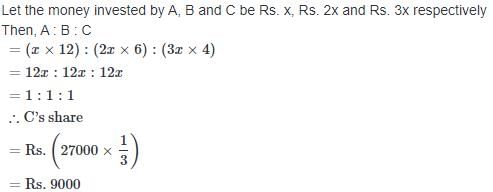
X and Y are partners in a business. They invest in the ratio 5 : 6, at the end of 8 months X withdraws his capital. If they receive profits in the ratio of 5 : 9. Find how long Y's investment was used ?- a)12 months
- b)10 months
- c)15 months
- d)14 months
Correct answer is option 'A'. Can you explain this answer?
X and Y are partners in a business. They invest in the ratio 5 : 6, at the end of 8 months X withdraws his capital. If they receive profits in the ratio of 5 : 9. Find how long Y's investment was used ?
a)
12 months
b)
10 months
c)
15 months
d)
14 months
|
|
Aarav Sharma answered |
Given:
- X and Y are partners in a business.
- They invest in the ratio 5:6.
- X withdraws his capital at the end of 8 months.
- They receive profits in the ratio 5:9.
To find:
- The duration for which Y's investment was used.
Solution:
Let's assume that X invested 5x and Y invested 6x.
Investment Ratio:
X's investment = 5x
Y's investment = 6x
Profit Sharing Ratio:
X's profit share = 5
Y's profit share = 9
Calculation:
Since X withdraws his capital after 8 months, his investment is used for 8 months. Therefore, the ratio of their investments for the remaining duration is:
X's investment = 5x (for 8 months)
Y's investment = 6x (for the remaining months)
The profit sharing ratio is given as 5:9, which means that the ratio of their investments is equal to the ratio of their profit shares. So, we can set up the following equation:
5x/8 = 5/9
Cross-multiplying:
45x = 40
Dividing by 45:
x = 40/45
x = 8/9
Calculating Y's investment:
Y's investment = 6x
Y's investment = 6 * (8/9)
Y's investment = 48/9
Y's investment = 16/3
Calculating the duration for which Y's investment was used:
Since X's investment was used for 8 months, Y's investment was used for the remaining duration:
Total duration - X's duration = Y's duration
12 months - 8 months = 4 months
Therefore, Y's investment was used for 4 months.
Conclusion:
The duration for which Y's investment was used is 4 months, which is equivalent to option A.
- X and Y are partners in a business.
- They invest in the ratio 5:6.
- X withdraws his capital at the end of 8 months.
- They receive profits in the ratio 5:9.
To find:
- The duration for which Y's investment was used.
Solution:
Let's assume that X invested 5x and Y invested 6x.
Investment Ratio:
X's investment = 5x
Y's investment = 6x
Profit Sharing Ratio:
X's profit share = 5
Y's profit share = 9
Calculation:
Since X withdraws his capital after 8 months, his investment is used for 8 months. Therefore, the ratio of their investments for the remaining duration is:
X's investment = 5x (for 8 months)
Y's investment = 6x (for the remaining months)
The profit sharing ratio is given as 5:9, which means that the ratio of their investments is equal to the ratio of their profit shares. So, we can set up the following equation:
5x/8 = 5/9
Cross-multiplying:
45x = 40
Dividing by 45:
x = 40/45
x = 8/9
Calculating Y's investment:
Y's investment = 6x
Y's investment = 6 * (8/9)
Y's investment = 48/9
Y's investment = 16/3
Calculating the duration for which Y's investment was used:
Since X's investment was used for 8 months, Y's investment was used for the remaining duration:
Total duration - X's duration = Y's duration
12 months - 8 months = 4 months
Therefore, Y's investment was used for 4 months.
Conclusion:
The duration for which Y's investment was used is 4 months, which is equivalent to option A.
Sonia started a business investing Rs. 60000. After 6 months Vivek joined him with an amount of Rs. 140000. After 1 year Kirti also joined them with Rs. 120000. After 2 years the business yielded a total profit of Rs. 450000. What is the share of Vivek in the profit ?- a)Rs. 140000
- b)Rs. 198500
- c)Rs. 210000
- d)Rs. 215000
- e)None of these
Correct answer is option 'C'. Can you explain this answer?
Sonia started a business investing Rs. 60000. After 6 months Vivek joined him with an amount of Rs. 140000. After 1 year Kirti also joined them with Rs. 120000. After 2 years the business yielded a total profit of Rs. 450000. What is the share of Vivek in the profit ?
a)
Rs. 140000
b)
Rs. 198500
c)
Rs. 210000
d)
Rs. 215000
e)
None of these

|
Krithika Patel answered |
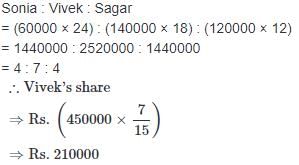
P and Q started a business investing Rs 85000 and Rs 15000 resp. In what ratio the profit earned after 2 years be divided between P and Q respectively.- a)17 : 5
- b)17 : 3
- c)17 : 6
- d)17 : 7
Correct answer is option 'B'. Can you explain this answer?
P and Q started a business investing Rs 85000 and Rs 15000 resp. In what ratio the profit earned after 2 years be divided between P and Q respectively.
a)
17 : 5
b)
17 : 3
c)
17 : 6
d)
17 : 7

|
Ashish Chawla answered |
In this type of question as time frame for both investors is equal then just get the ratio of their investments.
P : Q = 85000 : 15000
= 85 : 15
= 17 : 3
P : Q = 85000 : 15000
= 85 : 15
= 17 : 3
Three partners A , B , C start a business . B's Capital is four times C's capital and twice A's capital is equal to thrice B's capital . If the total profit is Rs 16500 at the end of a year ,Find out B's share in it.- a)Rs. 4000
- b)Rs. 5000
- c)Rs. 6000
- d)Rs. 7000
Correct answer is option 'C'. Can you explain this answer?
Three partners A , B , C start a business . B's Capital is four times C's capital and twice A's capital is equal to thrice B's capital . If the total profit is Rs 16500 at the end of a year ,Find out B's share in it.
a)
Rs. 4000
b)
Rs. 5000
c)
Rs. 6000
d)
Rs. 7000

|
Om Banerjee answered |
Suppose C's capital = x then
B's capital = 4x (Since B's Capital is four times C's capital)
A's capital = 6x ( Since twice A's capital is equal to thrice B's capital)
A : B : C =6x : 4x : x
= 6 : 4 : 1
B's share
B's capital = 4x (Since B's Capital is four times C's capital)
A's capital = 6x ( Since twice A's capital is equal to thrice B's capital)
A : B : C =6x : 4x : x
= 6 : 4 : 1
B's share

A working partner gets 20% as his commission of the profit after his commission is paid. If the working partner's commission is Rs. 8000, then what is the total profit in the business ?- a)Rs. 47000
- b)Rs. 45000
- c)Rs. 48000
- d)None of these
Correct answer is option 'C'. Can you explain this answer?
A working partner gets 20% as his commission of the profit after his commission is paid. If the working partner's commission is Rs. 8000, then what is the total profit in the business ?
a)
Rs. 47000
b)
Rs. 45000
c)
Rs. 48000
d)
None of these

|
Varun Nambiar answered |
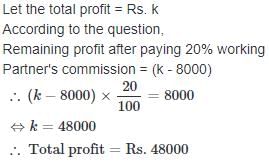
A, B, C subscribe Rs. 50,000 for a business. A subscribes Rs. 4000 more than B and B Rs. 5000 more than C. Out of a total profit of Rs. 35,000, A receives- a)Rs. 8400
- b)Rs. 11,900
- c)Rs. 13,600
- d)Rs. 14,700
Correct answer is option 'D'. Can you explain this answer?
A, B, C subscribe Rs. 50,000 for a business. A subscribes Rs. 4000 more than B and B Rs. 5000 more than C. Out of a total profit of Rs. 35,000, A receives
a)
Rs. 8400
b)
Rs. 11,900
c)
Rs. 13,600
d)
Rs. 14,700

|
Debanshi Patel answered |
Let C = x.
Then, B = x + 5000 and A = x + 5000 + 4000 = x + 9000
So, x + x + 5000 + x + 9000 = 50000
⇒ 3x = 36000
⇒ x = 12000
A : B : C = 21000 : 17000 : 12000 = 21 : 17 : 12
So A's Share

Then, B = x + 5000 and A = x + 5000 + 4000 = x + 9000
So, x + x + 5000 + x + 9000 = 50000
⇒ 3x = 36000
⇒ x = 12000
A : B : C = 21000 : 17000 : 12000 = 21 : 17 : 12
So A's Share

Simran started a software business by investing Rs. 50,000. After six months, Nanda joined her with a capital of Rs. 80,000. After 3 years, they earned a profit of Rs. 24,500. What was Simran's share in the profit?- a)Rs. 9,423
- b)Rs. 10,250
- c)Rs. 12,500
- d)Rs. 10,500
Correct answer is option 'D'. Can you explain this answer?
Simran started a software business by investing Rs. 50,000. After six months, Nanda joined her with a capital of Rs. 80,000. After 3 years, they earned a profit of Rs. 24,500. What was Simran's share in the profit?
a)
Rs. 9,423
b)
Rs. 10,250
c)
Rs. 12,500
d)
Rs. 10,500

|
Saumya Menon answered |
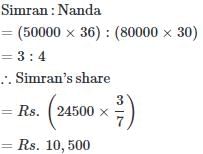
Three partners shared the profit in a business in the ratio 5 : 7 : 8. They had partnered for 14 months, 8 months and 7 months respectively. What was the ratio of their investments?- a)5 : 7 : 8
- b)20 : 49 : 64
- c)38 : 28 : 21
- d)None of these
Correct answer is option 'B'. Can you explain this answer?
Three partners shared the profit in a business in the ratio 5 : 7 : 8. They had partnered for 14 months, 8 months and 7 months respectively. What was the ratio of their investments?
a)
5 : 7 : 8
b)
20 : 49 : 64
c)
38 : 28 : 21
d)
None of these

|
Vandana Sarkar answered |
Let their investments be Rs. x for 14 months, Rs. y for 8 months and Rs. z for 7 months respectively.
Then, 14x : 8y : 7z = 5 : 7 : 8.
Now,
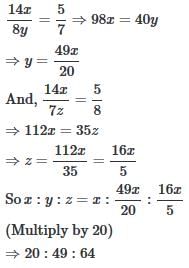
Then, 14x : 8y : 7z = 5 : 7 : 8.
Now,

A, B and C enter into a partnership investing Rs 35000, Rs 45000 and Rs 55000 resp. The respective share of A,B and C in an annual profit of Rs 40500 are.- a)Rs. 11500, Rs. 13500, Rs. 16500
- b)Rs. 10500, Rs. 12500, Rs. 16500
- c)Rs. 10500, Rs. 13500, Rs. 15500
- d)Rs. 10500, Rs. 13500, Rs. 16500
Correct answer is option 'D'. Can you explain this answer?
A, B and C enter into a partnership investing Rs 35000, Rs 45000 and Rs 55000 resp. The respective share of A,B and C in an annual profit of Rs 40500 are.
a)
Rs. 11500, Rs. 13500, Rs. 16500
b)
Rs. 10500, Rs. 12500, Rs. 16500
c)
Rs. 10500, Rs. 13500, Rs. 15500
d)
Rs. 10500, Rs. 13500, Rs. 16500

|
Saumya Menon answered |
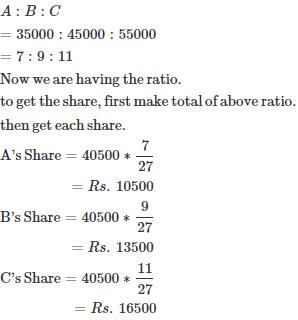
Prakash, Sachin and Anil started a business jointly investing Rs. 11 lakh, Rs. 16.5 lakh and Rs.8.25 lakh respectively. The profit earned by them in the business at the end of 3 years was Rs. 5 lakh. What will be 50% of Anil's share in the profit ?- a)Rs. 2.25 lakh
- b)Rs. 2.50 lakh
- c)Rs. 3.75 lakh
- d)Rs. 4.50 lakh
- e)None of these
Correct answer is option 'A'. Can you explain this answer?
Prakash, Sachin and Anil started a business jointly investing Rs. 11 lakh, Rs. 16.5 lakh and Rs.8.25 lakh respectively. The profit earned by them in the business at the end of 3 years was Rs. 5 lakh. What will be 50% of Anil's share in the profit ?
a)
Rs. 2.25 lakh
b)
Rs. 2.50 lakh
c)
Rs. 3.75 lakh
d)
Rs. 4.50 lakh
e)
None of these

|
Ashish Chawla answered |
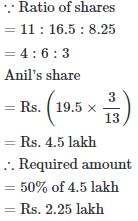
A and B started a business in partnership investing Rs. 20,000 and Rs. 15,000 respectively. After six months, C joined them with Rs. 20,000. What will be B's share in total profit of Rs. 25,000 earned at the end of 2 years from the starting of the business?- a)Rs. 7500
- b)Rs. 9000
- c)Rs. 9500
- d)Rs. 10,000
Correct answer is option 'A'. Can you explain this answer?
A and B started a business in partnership investing Rs. 20,000 and Rs. 15,000 respectively. After six months, C joined them with Rs. 20,000. What will be B's share in total profit of Rs. 25,000 earned at the end of 2 years from the starting of the business?
a)
Rs. 7500
b)
Rs. 9000
c)
Rs. 9500
d)
Rs. 10,000
|
|
Aarav Sharma answered |
Given:
Investment of A = Rs. 20,000
Investment of B = Rs. 15,000
Investment of C = Rs. 20,000 (after 6 months)
Total profit = Rs. 25,000
Time period = 2 years
Solution:
Let the profit share of A, B, and C be x, y, and z respectively.
Total investment = Investment of A + Investment of B + Investment of C
= Rs. (20,000 + 15,000 + 20,000)
= Rs. 55,000
A's investment was used for the entire 2-year period, B's investment was used for the entire 2-year period, and C's investment was used for only 1.5 years (6 months + 2 years - 6 months).
A's profit share = (20,000/55,000) × 2x = 4x/11
B's profit share = (15,000/55,000) × 2y = 4y/11
C's profit share = (20,000/55,000) × 1.5z = 3z/11
Total profit share = A's profit share + B's profit share + C's profit share
25000 = 4x/11 + 4y/11 + 3z/11
Since we don't know the profit share of A, B, and C, we need another equation to solve for them.
Let's find the ratio of investment of A, B, and C:
A : B : C = 20,000 : 15,000 : 20,000
= 4 : 3 : 4
Let the profit share of B be y.
Then, the profit share of A and C will be 4y/3 and 4y/3 respectively.
Substitute these values in the equation for total profit share:
25000 = 4(4y/3)/11 + 4y/11 + 3(4y/3)/11
25000 = 16y/33 + 4y/11 + 4y/11
25000 = 24y/33
y = (25000 × 33)/24
y = Rs. 34,375
B's profit share = Rs. 34,375
Therefore, A's profit share = 4y/3 = (4/3) × 34,375 = Rs. 45,833.33
C's profit share = 4y/3 = (4/3) × 34,375 = Rs. 45,833.33
Therefore, B's share in the total profit of Rs. 25,000 earned at the end of 2 years from the starting of the business is:
B's profit share = Rs. 34,375
Total profit = Rs. 25,000
B's share = (34,375/55,000) × 25,000
B's share = Rs. 15,625
Hence, option (A) Rs. 7500 is the correct answer.
Investment of A = Rs. 20,000
Investment of B = Rs. 15,000
Investment of C = Rs. 20,000 (after 6 months)
Total profit = Rs. 25,000
Time period = 2 years
Solution:
Let the profit share of A, B, and C be x, y, and z respectively.
Total investment = Investment of A + Investment of B + Investment of C
= Rs. (20,000 + 15,000 + 20,000)
= Rs. 55,000
A's investment was used for the entire 2-year period, B's investment was used for the entire 2-year period, and C's investment was used for only 1.5 years (6 months + 2 years - 6 months).
A's profit share = (20,000/55,000) × 2x = 4x/11
B's profit share = (15,000/55,000) × 2y = 4y/11
C's profit share = (20,000/55,000) × 1.5z = 3z/11
Total profit share = A's profit share + B's profit share + C's profit share
25000 = 4x/11 + 4y/11 + 3z/11
Since we don't know the profit share of A, B, and C, we need another equation to solve for them.
Let's find the ratio of investment of A, B, and C:
A : B : C = 20,000 : 15,000 : 20,000
= 4 : 3 : 4
Let the profit share of B be y.
Then, the profit share of A and C will be 4y/3 and 4y/3 respectively.
Substitute these values in the equation for total profit share:
25000 = 4(4y/3)/11 + 4y/11 + 3(4y/3)/11
25000 = 16y/33 + 4y/11 + 4y/11
25000 = 24y/33
y = (25000 × 33)/24
y = Rs. 34,375
B's profit share = Rs. 34,375
Therefore, A's profit share = 4y/3 = (4/3) × 34,375 = Rs. 45,833.33
C's profit share = 4y/3 = (4/3) × 34,375 = Rs. 45,833.33
Therefore, B's share in the total profit of Rs. 25,000 earned at the end of 2 years from the starting of the business is:
B's profit share = Rs. 34,375
Total profit = Rs. 25,000
B's share = (34,375/55,000) × 25,000
B's share = Rs. 15,625
Hence, option (A) Rs. 7500 is the correct answer.
P and Q started a business in the ratio of 2 : 3. After 1 year P left the business but Q continues. After 2 years he had profit of Rs. 26000. What is the profit of Q?- a)Rs. 10400
- b)Rs. 13000
- c)Rs. 15600
- d)Rs. 18500
- e)None of these
Correct answer is option 'E'. Can you explain this answer?
P and Q started a business in the ratio of 2 : 3. After 1 year P left the business but Q continues. After 2 years he had profit of Rs. 26000. What is the profit of Q?
a)
Rs. 10400
b)
Rs. 13000
c)
Rs. 15600
d)
Rs. 18500
e)
None of these

|
Aashna Roy answered |
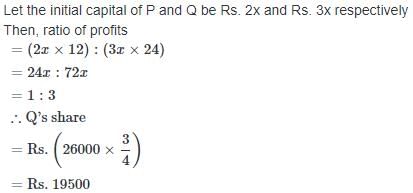
Three persons stared a placement business with a capital of Rs. 3000. B invests Rs. 600 less than A and C invests Rs. 300 less than B. What is B's share in a profit of Rs. 886 ?- a)Rs. 443
- b)Rs. 354.40
- c)Rs. 265.80
- d)Rs. 177.20
Correct answer is option 'C'. Can you explain this answer?
Three persons stared a placement business with a capital of Rs. 3000. B invests Rs. 600 less than A and C invests Rs. 300 less than B. What is B's share in a profit of Rs. 886 ?
a)
Rs. 443
b)
Rs. 354.40
c)
Rs. 265.80
d)
Rs. 177.20

|
Aditi Banerjee answered |
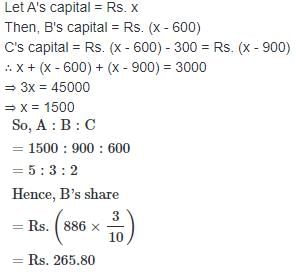
A, B and C enter into a partnership. They invest Rs. 40000, Rs. 80000 and Rs. 120000 respectively. At the end of the first year, B withdraws Rs. 40000, while at the end of the second year, C withdraws Rs. 80000. In what ratio will the profit be shared at the end of 3 years ?- a)2 : 3 : 5
- b)3 : 4 : 7
- c)4 : 5 :9
- d)None of these
Correct answer is option 'B'. Can you explain this answer?
A, B and C enter into a partnership. They invest Rs. 40000, Rs. 80000 and Rs. 120000 respectively. At the end of the first year, B withdraws Rs. 40000, while at the end of the second year, C withdraws Rs. 80000. In what ratio will the profit be shared at the end of 3 years ?
a)
2 : 3 : 5
b)
3 : 4 : 7
c)
4 : 5 :9
d)
None of these

|
Mayank Sharma answered |
A : B : C
(40000 × 36) :(80000 × 12 + 40000 × 24) : (120000 × 24 + 40000 × 12)
= 144 : 192 : 336
= 3 : 4 : 7
(40000 × 36) :(80000 × 12 + 40000 × 24) : (120000 × 24 + 40000 × 12)
= 144 : 192 : 336
= 3 : 4 : 7
A and B entered into partnership with capitals in the ratio 4 : 5. After 3 months, A withdrew 1/4 of his capital and B withdrew 1/5 of his capital. The gain at the end of 10 months was Rs. 760. A's share in this profit is:- a)Rs. 330
- b)Rs. 360
- c)Rs. 380
- d)Rs. 430
Correct answer is option 'A'. Can you explain this answer?
A and B entered into partnership with capitals in the ratio 4 : 5. After 3 months, A withdrew 1/4 of his capital and B withdrew 1/5 of his capital. The gain at the end of 10 months was Rs. 760. A's share in this profit is:
a)
Rs. 330
b)
Rs. 360
c)
Rs. 380
d)
Rs. 430

|
Debanshi Patel answered |
A:B

=(12x+21x):(15x+28x)
=33x:43x
=33:43
∴A's share
=Rs.330

=(12x+21x):(15x+28x)
=33x:43x
=33:43
∴A's share

=Rs.330
Sumit and Ravi started a business by investing Rs 85000 and 15000 respectively. In what ratio the profit earned after 2 years be divided between Sumit and Ravi respectively.- a)17 : 1
- b)17 : 2
- c)17 : 3
- d)17 : 4
Correct answer is option 'C'. Can you explain this answer?
Sumit and Ravi started a business by investing Rs 85000 and 15000 respectively. In what ratio the profit earned after 2 years be divided between Sumit and Ravi respectively.
a)
17 : 1
b)
17 : 2
c)
17 : 3
d)
17 : 4

|
Abhishek Mehra answered |
Note: If you have clear concept of ratio and proportion chapter then it will really easy for you to solve partnership problems.
P : Q = 85000 : 15000 = 17 : 3
Important to note there that if both have invested for different period of times then we had to multiply with number of months to get the desired ratio.
P : Q = 85000 : 15000 = 17 : 3
Important to note there that if both have invested for different period of times then we had to multiply with number of months to get the desired ratio.
Arun, Kamal and Vinay invested Rs. 8000, Rs. 4000 and Rs. 8000 respectively in a business. Arun left after six months. If after eight months, there was a gain of Rs. 4005, then what will be the share of Kamal?- a)Rs. 890
- b)Rs. 1335
- c)Rs. 1602
- d)Rs. 1780
Correct answer is option 'A'. Can you explain this answer?
Arun, Kamal and Vinay invested Rs. 8000, Rs. 4000 and Rs. 8000 respectively in a business. Arun left after six months. If after eight months, there was a gain of Rs. 4005, then what will be the share of Kamal?
a)
Rs. 890
b)
Rs. 1335
c)
Rs. 1602
d)
Rs. 1780

|
Sarthak Chatterjee answered |
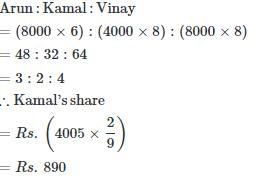
A, B, C subscribe Rs. 50,000 for a business. A subscribes Rs. 4000 more than B and B Rs. 5000 more than C. Out of a total profit of Rs. 35,000, A receives:- a)Rs. 8400
- b)Rs. 11,900
- c)Rs. 13,600
- d)Rs. 14,700
Correct answer is option 'D'. Can you explain this answer?
A, B, C subscribe Rs. 50,000 for a business. A subscribes Rs. 4000 more than B and B Rs. 5000 more than C. Out of a total profit of Rs. 35,000, A receives:
a)
Rs. 8400
b)
Rs. 11,900
c)
Rs. 13,600
d)
Rs. 14,700

|
Debanshi Patel answered |
Let C=x
Then, B=x+5000 and
A=x+5000+4000
=x+9000
So, x+x+5000+x+9000=50000
⇒3x=36000
⇒x=12000
A:B:C=21000:17000:12000
=21:17:12
∴A's share

Then, B=x+5000 and
A=x+5000+4000
=x+9000
So, x+x+5000+x+9000=50000
⇒3x=36000
⇒x=12000
A:B:C=21000:17000:12000
=21:17:12
∴A's share

Four milkmen rented a pasture. M put to graze 16 cows for 3 months and N 20 cows for 4 months, O 18 cows for 6 months and P 42 cows for 2 months. If M's share of rent be Rs. 2400, the rent paid by O is ?- a)Rs. 3200
- b)Rs. 4200
- c)Rs. 4000
- d)Rs. 5400
Correct answer is option 'D'. Can you explain this answer?
Four milkmen rented a pasture. M put to graze 16 cows for 3 months and N 20 cows for 4 months, O 18 cows for 6 months and P 42 cows for 2 months. If M's share of rent be Rs. 2400, the rent paid by O is ?
a)
Rs. 3200
b)
Rs. 4200
c)
Rs. 4000
d)
Rs. 5400

|
Srestha Nair answered |
M graze 16 cows for 3 months.
N graze 20 cows for 4 months.
O graze 18 cows for 6 months.
P graze 42 cows for 2 months.
So, Ration of Rent
= M : N : O : P
= (16 × 3) : (20 × 4) : (18 × 6) : (42 × 2)
= 48 : 80 : 108 : 84
= 12 : 20 : 27 : 21
According to the question,
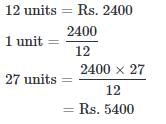
N graze 20 cows for 4 months.
O graze 18 cows for 6 months.
P graze 42 cows for 2 months.
So, Ration of Rent
= M : N : O : P
= (16 × 3) : (20 × 4) : (18 × 6) : (42 × 2)
= 48 : 80 : 108 : 84
= 12 : 20 : 27 : 21
According to the question,

Kamal started a business investing Rs 9000. After five months, Sameer joined with a capital of Rs 8000. If at the end of the year, they earn a profit of Rs. 6970, then what will be the share of Sameer in the profit ?- a)Rs 2380
- b)Rs 2300
- c)Rs 2280
- d)Rs 2260
Correct answer is option 'A'. Can you explain this answer?
Kamal started a business investing Rs 9000. After five months, Sameer joined with a capital of Rs 8000. If at the end of the year, they earn a profit of Rs. 6970, then what will be the share of Sameer in the profit ?
a)
Rs 2380
b)
Rs 2300
c)
Rs 2280
d)
Rs 2260

|
Debanshi Patel answered |
Now as per question, Kamal invested for 12 months and Sameer invested for 7 months.
So Kamal : Sameer = (9000 × 12) : (8000 × 7)
= 108 : 56
= 27 : 14
Sameer Ratio in profit will be

So Kamal : Sameer = (9000 × 12) : (8000 × 7)
= 108 : 56
= 27 : 14
Sameer Ratio in profit will be

Nirmal and Kapil started a business investing Rs. 9000 and Rs. 12000 respectively. After 6 months, Kapil withdrew half of his investment. If after a year, the total profit was Rs. 4600, what was Kapil’s share initially ?- a)Rs 2300
- b)Rs 2400
- c)Rs 2500
- d)None of above
Correct answer is option 'A'. Can you explain this answer?
Nirmal and Kapil started a business investing Rs. 9000 and Rs. 12000 respectively. After 6 months, Kapil withdrew half of his investment. If after a year, the total profit was Rs. 4600, what was Kapil’s share initially ?
a)
Rs 2300
b)
Rs 2400
c)
Rs 2500
d)
None of above
|
|
Aarav Sharma answered |
Let's calculate the share of Nirmal and Kapil in the total profit.
Nirmal's investment = Rs. 9000
Kapil's investment = Rs. 12000
They were in business for a year, so Nirmal's share of the profit after a year = (9000/21000) * 4600 = Rs. 1960
After 6 months, Kapil withdrew half of his investment, so his remaining investment = 12000/2 = Rs. 6000
Kapil's share of the profit after a year = (6000/21000) * 4600 = Rs. 1310
Therefore, Kapil's share of the profit was Rs. 1310.
Nirmal's investment = Rs. 9000
Kapil's investment = Rs. 12000
They were in business for a year, so Nirmal's share of the profit after a year = (9000/21000) * 4600 = Rs. 1960
After 6 months, Kapil withdrew half of his investment, so his remaining investment = 12000/2 = Rs. 6000
Kapil's share of the profit after a year = (6000/21000) * 4600 = Rs. 1310
Therefore, Kapil's share of the profit was Rs. 1310.
A and B invest in a business in the ratio 3 : 2. If 5% of the total profit goes to charity and A's share is Rs. 855, the total profit is:- a)Rs. 1425
- b)Rs. 1500
- c)Rs. 1537.50
- d)Rs. 1576
Correct answer is option 'B'. Can you explain this answer?
A and B invest in a business in the ratio 3 : 2. If 5% of the total profit goes to charity and A's share is Rs. 855, the total profit is:
a)
Rs. 1425
b)
Rs. 1500
c)
Rs. 1537.50
d)
Rs. 1576

|
Nandini Deshpande answered |
Let the total profitbe Rs.100 After paying to charity, A's share

If A's share is Rs.57,
Total profit=Rs.100
If A's share Rs.855,
Total profit


If A's share is Rs.57,
Total profit=Rs.100
If A's share Rs.855,
Total profit

A and B started a business in partnership investing Rs. 20,000 and Rs. 15,000 respectively. After six months, C joined them with Rs. 20,000. What will be B's share in total profit of Rs. 25,000 earned at the end of 2 years from the starting of the business?- a)Rs. 7500
- b)Rs. 9000
- c)Rs. 9500
- d)Rs. 10,000
Correct answer is option 'A'. Can you explain this answer?
A and B started a business in partnership investing Rs. 20,000 and Rs. 15,000 respectively. After six months, C joined them with Rs. 20,000. What will be B's share in total profit of Rs. 25,000 earned at the end of 2 years from the starting of the business?
a)
Rs. 7500
b)
Rs. 9000
c)
Rs. 9500
d)
Rs. 10,000
|
|
Aarav Sharma answered |
Given:
Investment of A = Rs. 20,000
Investment of B = Rs. 15,000
Investment of C = Rs. 20,000 (After 6 months)
Total profit earned = Rs. 25,000
Time period = 2 years
Solution:
Let's calculate the ratio of their investments:
Ratio of investment of A, B and C = 20,000 : 15,000 : 20,000 = 4 : 3 : 4
Let's calculate the profit of A and B for 2 years:
Profit of A and B for 2 years = (4/7) * 25,000 = Rs. 14,285.71
Now, C joined them after 6 months i.e. for 1.5 years, his share in the total profit will be:
Profit of C for 1.5 years = (4/11) * 25,000 = Rs. 9,090.91
Therefore, the total profit of B will be:
Total profit of B = Profit of A and B - Profit of C
Total profit of B = 14,285.71 - 9,090.91 = Rs. 5,194.80
Hence, the share of B in the total profit of Rs. 25,000 earned at the end of 2 years will be:
Share of B = (5,194.80/25,000) * 100 = 20.78%
B's share in the total profit of Rs. 25,000 earned at the end of 2 years from the starting of the business will be:
B's share = 20.78% of Rs. 25,000 = Rs. 7,500
Therefore, the correct answer is option (a) Rs. 7500.
Investment of A = Rs. 20,000
Investment of B = Rs. 15,000
Investment of C = Rs. 20,000 (After 6 months)
Total profit earned = Rs. 25,000
Time period = 2 years
Solution:
Let's calculate the ratio of their investments:
Ratio of investment of A, B and C = 20,000 : 15,000 : 20,000 = 4 : 3 : 4
Let's calculate the profit of A and B for 2 years:
Profit of A and B for 2 years = (4/7) * 25,000 = Rs. 14,285.71
Now, C joined them after 6 months i.e. for 1.5 years, his share in the total profit will be:
Profit of C for 1.5 years = (4/11) * 25,000 = Rs. 9,090.91
Therefore, the total profit of B will be:
Total profit of B = Profit of A and B - Profit of C
Total profit of B = 14,285.71 - 9,090.91 = Rs. 5,194.80
Hence, the share of B in the total profit of Rs. 25,000 earned at the end of 2 years will be:
Share of B = (5,194.80/25,000) * 100 = 20.78%
B's share in the total profit of Rs. 25,000 earned at the end of 2 years from the starting of the business will be:
B's share = 20.78% of Rs. 25,000 = Rs. 7,500
Therefore, the correct answer is option (a) Rs. 7500.
Manoj received Rs. 6000 as his share out of the total profit of Rs. 9000 which he and Ramesh earned at the end of one year. If Manoj invested Rs.20000 for 6 months, whereas Ramesh invested his amount for the whole year, what was the amount invested by Ramesh- a)Rs. 2000
- b)Rs. 3000
- c)Rs. 4000
- d)Rs. 5000
Correct answer is option 'D'. Can you explain this answer?
Manoj received Rs. 6000 as his share out of the total profit of Rs. 9000 which he and Ramesh earned at the end of one year. If Manoj invested Rs.20000 for 6 months, whereas Ramesh invested his amount for the whole year, what was the amount invested by Ramesh
a)
Rs. 2000
b)
Rs. 3000
c)
Rs. 4000
d)
Rs. 5000
|
|
Alok Verma answered |
Suppose Ramesh invested Rs. x. Then,
Manoj : Ramesh = 20000 * 6 : x × 12.
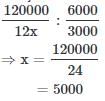
Manoj : Ramesh = 20000 * 6 : x × 12.

If 4 (P's Capital ) = 6 ( Q's Capital ) = 10 ( R's Capital ) , then out of the total profit of Rs 4650 , R will receive- a)Rs. 600
- b)Rs. 700
- c)Rs. 800
- d)Rs. 900
Correct answer is option 'D'. Can you explain this answer?
If 4 (P's Capital ) = 6 ( Q's Capital ) = 10 ( R's Capital ) , then out of the total profit of Rs 4650 , R will receive
a)
Rs. 600
b)
Rs. 700
c)
Rs. 800
d)
Rs. 900

|
Om Banerjee answered |
Let
P's capital = p,
Q's capital = q and
R's capital = r.
Then
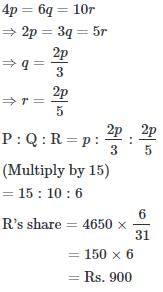
P's capital = p,
Q's capital = q and
R's capital = r.
Then

Shankar starts a business with an investment of Rs. 120000. After three months, Aniket joined him with an invesment of Rs. 190000. They earned a profit of Rs. 1750000 after one year. What is Aniket's share in the profit ?- a)Rs. 800000
- b)Rs. 850000
- c)Rs. 900000
- d)Rs. 950000
- e)None of these
Correct answer is option 'D'. Can you explain this answer?
Shankar starts a business with an investment of Rs. 120000. After three months, Aniket joined him with an invesment of Rs. 190000. They earned a profit of Rs. 1750000 after one year. What is Aniket's share in the profit ?
a)
Rs. 800000
b)
Rs. 850000
c)
Rs. 900000
d)
Rs. 950000
e)
None of these

|
Aashna Roy answered |
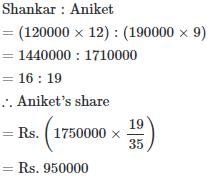
X and Y enter into a partnership with capitals in the ratio 5 : 6 and at the end of 8 months, X withdraws. If they receive profit in the ratio of 5 : 9. Find how long Y's capital was used.- a)8 months
- b)9 months
- c)11 months
- d)12 months
Correct answer is option 'D'. Can you explain this answer?
X and Y enter into a partnership with capitals in the ratio 5 : 6 and at the end of 8 months, X withdraws. If they receive profit in the ratio of 5 : 9. Find how long Y's capital was used.
a)
8 months
b)
9 months
c)
11 months
d)
12 months
|
|
Aarav Sharma answered |
Given:
Capital ratio of X and Y = 5:6
Profit ratio = 5:9
Let's assume the capitals of X and Y as 5x and 6x respectively.
After 8 months, X withdraws his capital.
So, the remaining capital of X = 5x * (1 - 8/12) = 5x * (4/12) = 5x/3
Now, let's calculate the profit distribution.
The profit ratio is given as 5:9, which is equivalent to (5/14):(9/14).
So, the profit share of X = (5/14) * (5x/3) = 25x/42
The profit share of Y = (9/14) * 6x = 54x/14 = 27x/7
Since the profit share of Y is greater than the profit share of X, it means Y's capital was used for a longer time.
Let's assume Y's capital was used for 't' months.
So, the total capital of Y for 't' months = 6x * t
Now, let's calculate the profit share of Y for 't' months.
Profit share of Y for 't' months = (5/14) * (6x * t) = 15xt/7
According to the given information, the profit share of Y is equal to 27x/7.
So, we can equate these two and solve for 't':
15xt/7 = 27x/7
15xt = 27x
t = 27/15
t = 9/5
t = 9 months
Therefore, Y's capital was used for 9 months.
Hence, the correct answer is option (d) 12 months.
Capital ratio of X and Y = 5:6
Profit ratio = 5:9
Let's assume the capitals of X and Y as 5x and 6x respectively.
After 8 months, X withdraws his capital.
So, the remaining capital of X = 5x * (1 - 8/12) = 5x * (4/12) = 5x/3
Now, let's calculate the profit distribution.
The profit ratio is given as 5:9, which is equivalent to (5/14):(9/14).
So, the profit share of X = (5/14) * (5x/3) = 25x/42
The profit share of Y = (9/14) * 6x = 54x/14 = 27x/7
Since the profit share of Y is greater than the profit share of X, it means Y's capital was used for a longer time.
Let's assume Y's capital was used for 't' months.
So, the total capital of Y for 't' months = 6x * t
Now, let's calculate the profit share of Y for 't' months.
Profit share of Y for 't' months = (5/14) * (6x * t) = 15xt/7
According to the given information, the profit share of Y is equal to 27x/7.
So, we can equate these two and solve for 't':
15xt/7 = 27x/7
15xt = 27x
t = 27/15
t = 9/5
t = 9 months
Therefore, Y's capital was used for 9 months.
Hence, the correct answer is option (d) 12 months.
A started a business with Rs.21,000 and is joined afterwards by B with Rs.36,000. After how many months did B join if the profits at the end of the year are divided equally?- a)4
- b)5
- c)6
- d)7
Correct answer is option 'B'. Can you explain this answer?
A started a business with Rs.21,000 and is joined afterwards by B with Rs.36,000. After how many months did B join if the profits at the end of the year are divided equally?
a)
4
b)
5
c)
6
d)
7

|
Swati Yadav answered |
Suppose B joined after x months
then,
21000 × 12 = 36000 × (12 - x)
⇒ 36x = 180
⇒ x = 5
then,
21000 × 12 = 36000 × (12 - x)
⇒ 36x = 180
⇒ x = 5
Arun started a business investing Rs. 38000. After 5 months Bakul joined him with a capital of Rs. 55000. At the end of the year the total profit was Rs. 22000. What is the approximate difference between the share of profits Arun and Bakul ?- a)Rs. 1007
- b)Rs. 1192
- c)RS. 1568
- d)Rs. 1857
- e)Rs. 1928
Correct answer is option 'D'. Can you explain this answer?
Arun started a business investing Rs. 38000. After 5 months Bakul joined him with a capital of Rs. 55000. At the end of the year the total profit was Rs. 22000. What is the approximate difference between the share of profits Arun and Bakul ?
a)
Rs. 1007
b)
Rs. 1192
c)
RS. 1568
d)
Rs. 1857
e)
Rs. 1928

|
Kajal Nair answered |
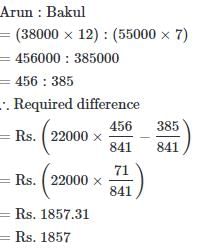
In a business, A and C invested amounts in the ratio 2 : 1 , whereas the ratio between amounts invested by A and B was 3 : 2 . If Rs 157300 was their profit, how much amount did B receive?- a)Rs. 48000
- b)Rs. 48200
- c)Rs. 48400
- d)Rs. 48600
Correct answer is option 'C'. Can you explain this answer?
In a business, A and C invested amounts in the ratio 2 : 1 , whereas the ratio between amounts invested by A and B was 3 : 2 . If Rs 157300 was their profit, how much amount did B receive?
a)
Rs. 48000
b)
Rs. 48200
c)
Rs. 48400
d)
Rs. 48600

|
Nandini Deshpande answered |
Assume that investment of C = x
Then, investment of A = 2x
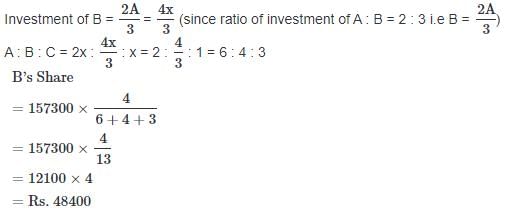
Then, investment of A = 2x

A and B started a business investing amount of Rs. 185000 and Rs. 225000 respectively. If B's share in the profit earned by them is Rs. 9000 then what is the total profit earned by them together ?- a)Rs. 17400
- b)Rs. 16400
- c)Rs. 16800
- d)Rs. 17800
Correct answer is option 'B'. Can you explain this answer?
A and B started a business investing amount of Rs. 185000 and Rs. 225000 respectively. If B's share in the profit earned by them is Rs. 9000 then what is the total profit earned by them together ?
a)
Rs. 17400
b)
Rs. 16400
c)
Rs. 16800
d)
Rs. 17800

|
Aditi Banerjee answered |
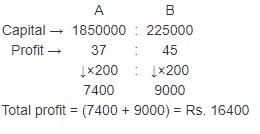
Chapter doubts & questions for Partnership - 4 Months Preparation Course for CLAT UG 2025 is part of CLAT exam preparation. The chapters have been prepared according to the CLAT exam syllabus. The Chapter doubts & questions, notes, tests & MCQs are made for CLAT 2025 Exam. Find important definitions, questions, notes, meanings, examples, exercises, MCQs and online tests here.
Chapter doubts & questions of Partnership - 4 Months Preparation Course for CLAT UG in English & Hindi are available as part of CLAT exam.
Download more important topics, notes, lectures and mock test series for CLAT Exam by signing up for free.

Contact Support
Our team is online on weekdays between 10 AM - 7 PM
Typical reply within 3 hours
|
Free Exam Preparation
at your Fingertips!
Access Free Study Material - Test Series, Structured Courses, Free Videos & Study Notes and Prepare for Your Exam With Ease

 Join the 10M+ students on EduRev
Join the 10M+ students on EduRev
|

|
Create your account for free
OR
Forgot Password
OR
Signup to see your scores
go up within 7 days!
Access 1000+ FREE Docs, Videos and Tests
Takes less than 10 seconds to signup

